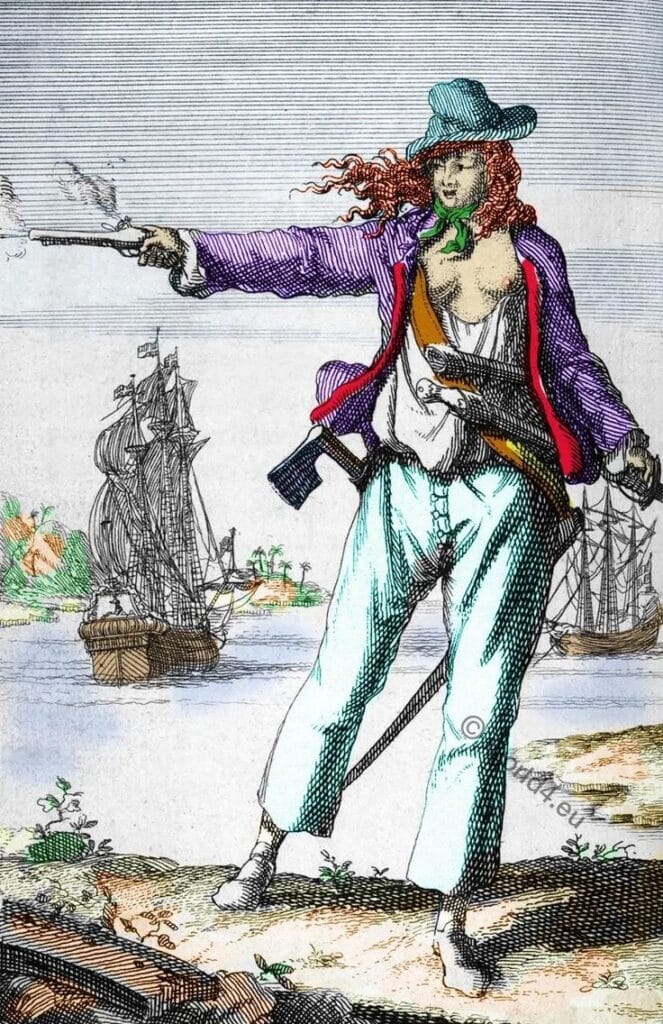When we think of pirates, images of rugged men with eye patches and peg legs come to mind. But Anne Bonny shattered this stereotype. She wasn’t just a pirate; she was a fierce, independent woman who stood against the oppressive norms of her time. Her story isn’t just about piracy; it’s about defiance, rebellion, and breaking free from the chains of patriarchy.

A Rebel from the Start
Anne Bonny was born around 1700 in Ireland. Her father was a wealthy lawyer who had an affair with her mother, a maid. This scandal forced them to move to the American colonies, settling in Charleston, South Carolina. Growing up in a society that thrived on the exploitation of enslaved people and rigid gender roles, Anne saw firsthand the injustices and inequalities around her.
Even as a young girl, Anne was rebellious. She wasn’t content to play the role society expected of her. She wanted more than a life of domesticity and subservience. This rebellious spirit set the stage for her future as a pirate.
Escaping the Chains
Anne’s marriage to James Bonny, a small-time pirate, was her first step towards freedom. But James was more interested in informing on pirates for the Governor of the Bahamas than living a life of adventure. Anne, dissatisfied with her husband’s lack of ambition, left him and joined forces with the notorious pirate John “Calico Jack” Rackham.
In Nassau, the pirate haven known as the “Republic of Pirates,” Anne found a community of outlaws who, like her, rejected the constraints of mainstream society. Here, she could finally break free from the chains of patriarchy and live the life she wanted.
A Pirate’s Life for Her
Anne Bonny quickly earned a reputation as a fierce and fearless pirate. Disguised as a man, she fought alongside her male counterparts, proving herself in countless raids and battles. Her partnership with Calico Jack was not just romantic but strategic, combining their strengths to become a formidable force on the high seas.
One of Anne’s most daring exploits was the capture of a heavily armed merchant ship off the coast of Jamaica. Leading the boarding party herself, she demonstrated her leadership and combat skills, challenging the notion that women were unfit for such roles.

A Feminist Before Her Time
Anne Bonny’s legacy goes beyond her life as a pirate. She is a symbol of feminist resistance. In an era when women were expected to be obedient and submissive, Anne carved out a space for herself in a male-dominated world. Her actions were a direct challenge to the patriarchal structures that sought to confine women to the domestic sphere.
Anne’s story is one of defiance and subversion. By disguising herself as a man, she used the system’s own rules against it, creating a new identity that allowed her to live on her terms.
The Bigger Picture
To understand Anne Bonny’s significance, we need to look at the broader socio-political context of her time. The early 18th century was a period of colonial expansion, economic exploitation, and social stratification. Pirates like Anne were not just criminals; they were rebels challenging the established order.
Pirate ships operated on principles of equality and democracy, starkly contrasting the rigid hierarchies on land. Anne’s presence in this environment highlights the intersection of gender and rebellion, showing how she and her fellow pirates created alternative communities that defied conventional norms.

Gender and Piracy
Anne’s story is especially powerful when viewed through the lens of gender. Her ability to transcend the limitations imposed by a patriarchal society underscores her strength and resilience. Her partnership with another female pirate, Mary Read, further illustrates the potential for solidarity among women in resisting male domination.
Together, Anne and Mary formed a formidable duo, challenging not only external authorities but also the internal gender norms of their crew. Their camaraderie and mutual support were revolutionary, demonstrating the power of women standing together against oppression.
The Trial and Aftermath
Anne Bonny’s capture and trial offer a glimpse into the legal and social attitudes toward piracy and gender at the time. In 1720, she and her crew were apprehended and taken to Spanish Town, Jamaica, to stand trial. The proceedings were a spectacle, with Anne and Mary Read’s gender becoming a focal point.
Sentenced to hang, both women were granted a temporary reprieve due to their pregnancies. This legal maneuver, known as “pleading the belly,” highlighted the unique challenges women faced even in the harsh world of piracy.

Myth and Reality
Anne Bonny’s life straddles the line between fact and legend. The lack of reliable primary sources has allowed her story to be embellished over time, adding to her mythic status. While this complicates historical analysis, it also attests to her enduring legacy.
Captain Charles Johnson’s “A General History of the Pyrates” provides one of the most detailed accounts of Bonny’s exploits. However, Johnson’s work is also sensationalized, reflecting the popular fascination with pirate lore and the complex interplay between history and storytelling.
The Best Pirate in History?
Anne Bonny’s life and legacy are a testament to the power of defiance and the human spirit’s capacity for rebellion. As a pirate, she challenged not only the laws of the sea but also the societal norms that sought to confine her. Her story is one of courage, resilience, and the relentless pursuit of freedom.
Arguably the best pirate in history, Anne Bonny’s impact extends beyond her individual exploits. She left a lasting mark on the socio-political landscape and remains a powerful symbol of feminist resistance. Her legacy continues to inspire, reminding us of the enduring power of those who dare to defy the conventions of their time.






